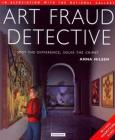That was a lovely post from Denise about art books. When our girls were little we used to take them to the National Gallery here in D.C. We'd have the same challenges with trying to interest them in the art, although they loved the buildings. They also loved the opportunity to pick out postcards: more interesting than the real things. The National Gallery eventually became known in our family as The Postcard Museum. Our many purchases decorated their rooms and the kitchen at about knee-level for many years, so I feel we gave them an art education that way.
 One of the art books I'm most fond of for older kids (maybe 7 or 8 and up) is
One of the art books I'm most fond of for older kids (maybe 7 or 8 and up) is Art Fraud Detective by Anna Nilsen. It's basically a spot-the-differences book with a loose plot. A fictional museum has just learned that most of its classic (real) paintings have been replaced by forgeries, and it's up to the reader to detect them. Most of the book is split pages: on the top are the paintings that are in the museum -- 30 fakes and 4 real ones. And on the bottom of the pages are the real paintings before the thefts. One flips pages until you have the two versions together, then you look to see if any details have been changed. These forgers also leave a rubber stamp-like "signature" on the fakes, so it's fairly easy to spot those little marks, but finding the alterations in the pictures is much harder. Most of the paintings are from the National Gallery in London -- artists include Botticelli, Holbein, DaVinci, Monet, Rembrandt, Vermeer and other Europeans. Nilsen went on to do two more: Art Auction Mystery, also a collection of mostly-European painters over the last three or four centuries, and The Great Art Scandal (now out of print), which is more modern: Monet to Warhol.
Earlier this week, a woman came into the store looking for coloring books "with information in them." It turned out that she's a volunteer in an Alzheimer's facility and some of the residents enjoy coloring. But she didn't want pictures which seemed infantilizing. We went through a number of options before we ended up with great series of coloring books about famous artists from Prestel Publishing. (The link gives you a chance to flip through a few pages.) These slightly over-size books give a page or two of background on the artist, then offer both fill-in-the-colors pictures, and partial pictures with prompts for the reader to draw the rest.
The Matisse book has four pages with big solid blocks of color:
Matisse wanted to represent things using shapes which were as simple as possible. That is why, one day, he had the idea of using scissors and glue. He cut patterns and shapes out of colored paper. You can try it too. You have some scissors and glue, don't you? You might like to add to Matisse's cut-out patterns which you can see in this book.Another two-page spread shows "The Dance" in color on the left -- five naked dancing women -- and on the right a line drawing of the same painting: "What colors would you like to use to complete these dancers?" A page in the Vermeer book shows part of "Soldier with a Laughing Girl" and asks, "What is the woman laughing about? What is the man telling her?"

 One of the things that makes this series so much fun is that despite the examples I've just used, many of the artists are ones which kids aren't likely to meet in basic art classes. Artists include Chagall, Miro, Hopper, Klimt, Kandinsky, Klee, Warhol and more. They're very kid-friendly -- and good for grown-ups too.
One of the things that makes this series so much fun is that despite the examples I've just used, many of the artists are ones which kids aren't likely to meet in basic art classes. Artists include Chagall, Miro, Hopper, Klimt, Kandinsky, Klee, Warhol and more. They're very kid-friendly -- and good for grown-ups too.Love,
Deborah


Dear Deborah and Annie
ReplyDeleteI've just discovered your blog and I am an instant fan! I will be a frequent visitor from now on! This particular post caught my eye because of the reference to the National Gallery. I am on staff there, have been for 20 years! I just wrote a children's book about the collection, titled Belle: The Amazing, Astonishingly Magical Journey of an Artfully Painted Lady.(Bunker Hill Publishing, 2011)I wrote it as a fanciful romp through the National Gallery, with a butterfly character who pops out of a 17th c. Dutch still life, precisely because I was looking for a new, fun way to inspire the 8 to 11 yr. old crowd to explore the galleries. If you've seen the book, I'd love to know what you think! But thanks so much for a great blog. I have a lot of fun reading to do to catch up!
Mary Lee Corlett